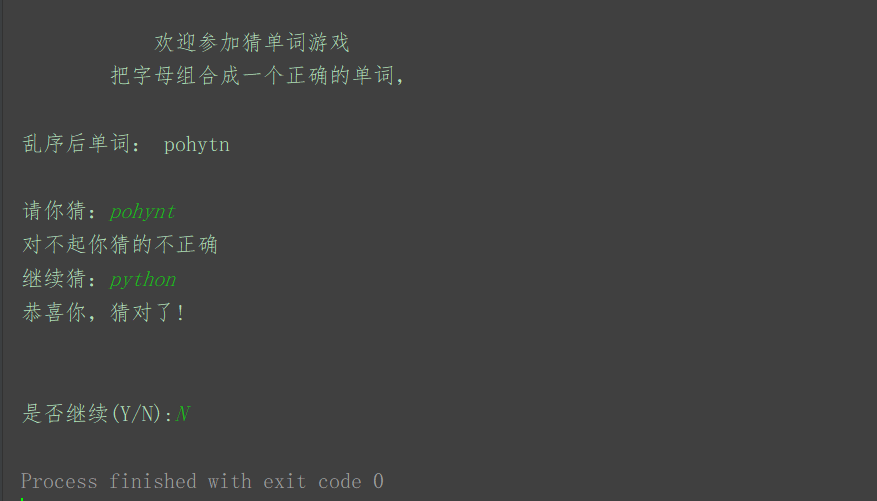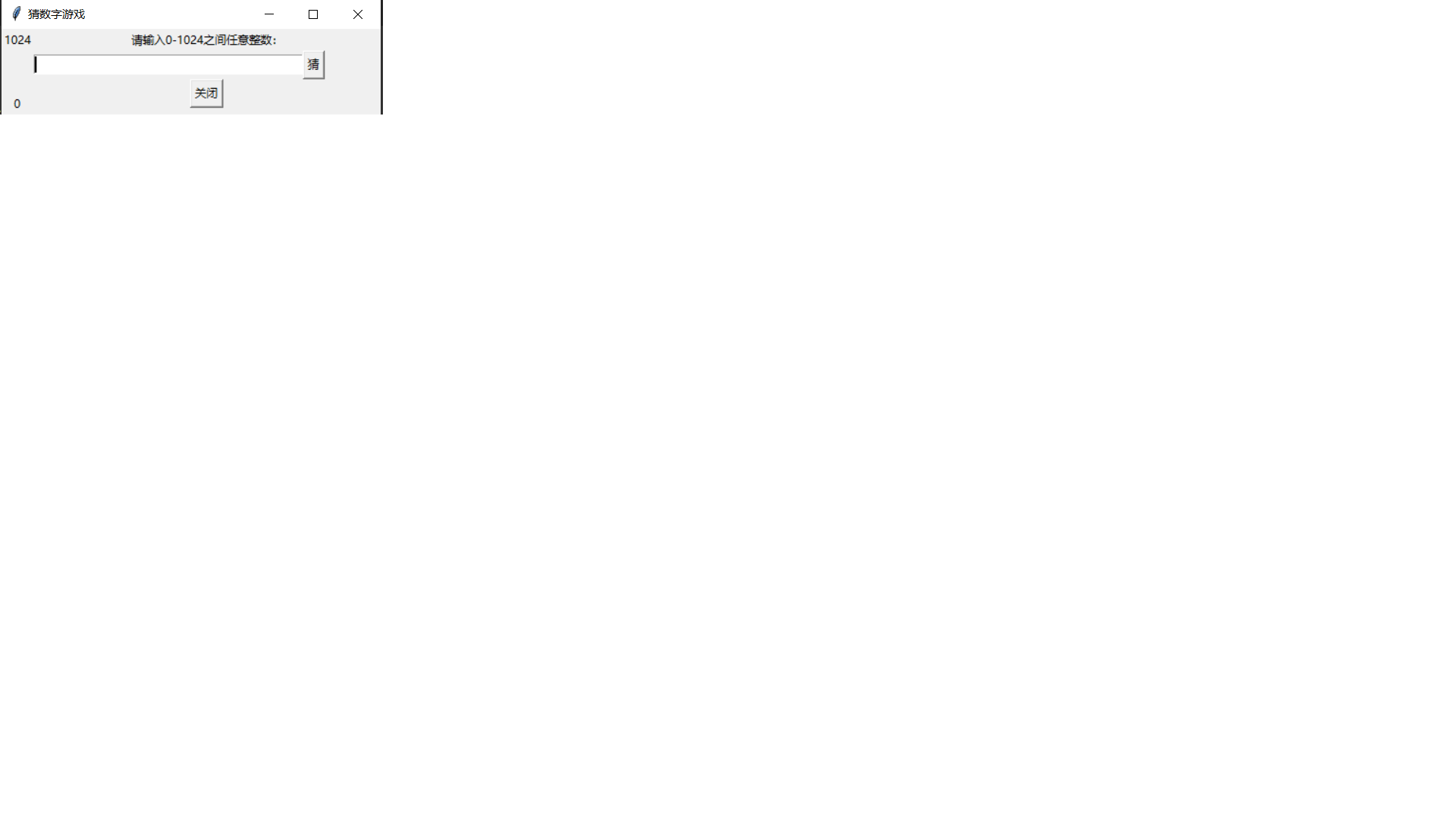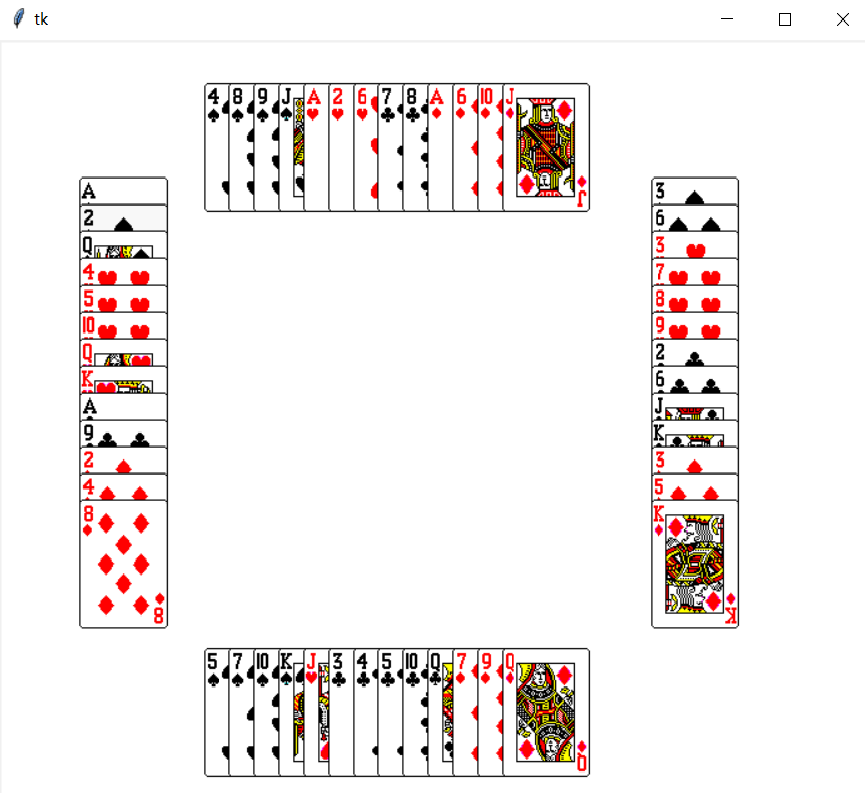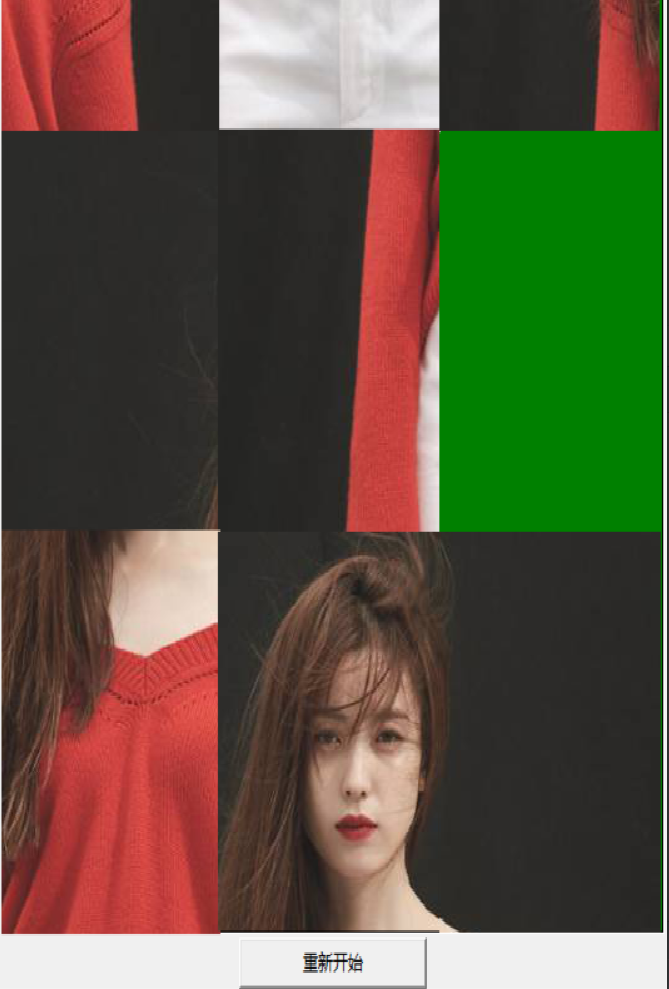1 word guessing game
- The game introduce: guess the word game is to calculate the soap machine to produce a word randomly, disorder the alphabet order, for the player to guess. This game uses the control character interface. In the game, tuples in the sequence can be used to store all the words to be guessed. Because the game of guessing words needs to randomly generate a word to be guessed and a random number, random module random number function is introduced. random.choice() can randomly select elements from a sequence.
Run code
from tkinter import * import random n=52 def gen_pocker(n): x=100 while(x>0): x=x-1 p1=random.randint(0,n-1) p2=random.randint(0,n-1) t=pocker[p1] pocker[p1]=pocker[p2] pocker[p2]=t return pocker pocker=[i for i in range(n)] pocker=gen_pocker(n) print(pocker) (player1,player2,player3,player4)=([],[],[],[]) (p1,p2,p3,p4)=([],[],[],[]) root=Tk() # Create a Canvas with a white background cv=Canvas(root,bg='white',width=700,height=600) imgs=[] for i in range(1,5): for j in range(1,14): imgs.insert((i-1)*13+(j-1),PhotoImage(file='images\\'+str(i)+'-'+str(j)+'.gif')) for x in range(13): #The 13 round m=x*4 p1.append(pocker[m]) p2.append(pocker[m+1]) p3.append(pocker[m+2]) p4.append(pocker[m+3]) p1.sort() p2.sort() p3.sort() p4.sort() for x in range(0,13): img=imgs[p1[x]] player1.append(cv.create_image((200+20*x,80),image=img)) img = imgs[p2[x]] player1.append(cv.create_image((100,150+20*x), image=img)) img = imgs[p3[x]] player1.append(cv.create_image((200 + 20 * x, 500), image=img)) img = imgs[p4[x]] player1.append(cv.create_image((560,150+20*x), image=img)) print("player1:",player1) print("player2:",player2) print("player3:",player3) print("player4:",player4) cv.pack() root.mainloop()
Run screenshots

2 licensing game
- The game is introduced: four famous brand players play cards, the computer randomly gives 52 cards (not big, Wang) to four players, and displays each player's cards on the screen.
Run code
# Card Moudule # Basic classes for a game with playing cards class Card(): """ A Playing card""" RANKS = ["A","2","3","4","5","6","7","8","9","10","J","Q","K"] SUITS = ["Plum blossom","square","red","black"] def __init__(self,rank,suit,face_up = True): self.rank = rank self.suit = suit self.is_face_up = face_up def __str__(self): if self.is_face_up: rep = self.suit + self.rank else: rep = "XX" return rep def flip(self): self.is_face_up = not self.is_face_up def pic_order(self): if self.rank == "A": FaceNum = 1 elif self.rank == "J": FaceNum = 11 elif self.rank == "Q": FaceNum = 12 elif self.rank == "K": FaceNum = 13 else: FaceNum = int(self.rank) if self.suit == "Plum blossom": Suit = 1 elif self.suit == "square": Suit = 2 elif self.suit == "red": Suit = 3 else: Suit = 4 return (Suit - 1) * 13 + FaceNum class Hand(): """A hand of plating card""" def __init__(self): self.cards = [] def __str__(self): if self.cards: rep = "" for card in self.cards: rep += str(card) + "\t" else: rep = "No cards" return rep def clear(self): self.cards = [] def add(self, card): self.cards.append(card) def give(self,card,other_hand): self.cards.remove(card) other_hand.add(card) class Poke(Hand): """A deck of playing cards""" def populate(self): for suit in Card.SUITS: for rank in Card.RANKS: self.add(Card(rank,suit)) def shuffle(self): import random random.shuffle(self.cards) def deal(self, hands, per_hand = 13): for rounds in range(per_hand): for hand in hands: top_card = self.cards[0] self.cards.remove(top_card) hand.add(top_card) if __name__ == "__main__": print("This is a module with classes for playing cards.") players = [Hand(),Hand(),Hand(),Hand()] poke1 = Poke() poke1.populate() poke1.shuffle() poke1.deal(players,13) n=1 for hand in players: print("card-game competitor",n,end=":") print(hand) n=n+1 input("\nPress the enter key to exit.")
Run screenshots

3 guess the number game
- Game introduction: in the game, the program randomly generates numbers within 1024, and then lets the players guess. If the number of guesses is too large or too small, it will prompt, and the program will also count the number of guesses. Use Tkinter to develop a number guessing game.
Run code
import tkinter as tk import sys import random import re number=random.randint(0,1024) running=True num=0 nmaxn=1024 nmin=0 def eBtnClose(event): root.destroy() def eBtnGuess(event): global nmaxn global nmin global num global running if running: val_a=int(entry_a.get()) if val_a==number: labelqval("Congratulations!") num+=1 running=False numGuess() elif val_a<number: if val_a>nmin: nmin=val_a num+=1 label_tip_min.config(label_tip_min,text=nmin) labelqval("Small.") else: if val_a <nmaxn: nmaxn = val_a num += 1 label_tip_max.config(label_tip_max, text=nmaxn) labelqval("Oh, big.") else: labelqval("You're right") def numGuess(): if num==1: labelqval("You're right!") elif num<10: labelqval("==Within ten times, I got the right answer... Number of attempts:"+str(num)) elif num<50: labelqval("OK, number of attempts:"+str(num)) else: labelqval("ok You've done it more than 50 times... Number of attempts:"+str(num)) def labelqval(vText): label_val_q.config(label_val_q,text=vText) root=tk.Tk(className="Figure guessing game") root.geometry("400x90+200+200") line_a_tip=tk.Frame(root) label_tip_max=tk.Label(line_a_tip,text=nmaxn) label_tip_min=tk.Label(line_a_tip,text=nmin) label_tip_max.pack(side="top",fill="x") label_tip_min.pack(side="bottom",fill="y") line_a_tip.pack(side="left",fill="y") line_question=tk.Frame(root) label_val_q=tk.Label(line_question,width="80") label_val_q.pack(side="left") line_question.pack(side="top",fill="x") line_input=tk.Frame(root) entry_a=tk.Entry(line_input,width="40") btnguess=tk.Button(line_input,text="guess") entry_a.pack(side="left") entry_a.bind('<Return>',eBtnGuess) btnguess.bind('<Button-1>',eBtnGuess) btnguess.pack(side="left") line_input.pack(side="top",fill="x") line_btn=tk.Frame(root) btnClose=tk.Button(line_btn,text="Close") btnClose.bind('<Button-1>',eBtnClose) btnClose.pack(side="left") line_btn.pack(side="top") labelqval("Please input 0-1024 Any integer between:") entry_a.focus_set() print(number) root.mainloop()
Run screenshots



4 graphic licensing game
- Introduction to the game: 52 cards (excluding king and Wang) will be randomly distributed to four players, and the cards of each player will be displayed on the screen. The operation effect of the program is shown in Figure 5-1. Next, we use Canvas to draw Tkinter module graphics as an example to introduce the method of building a simple GUI (graphical user interface) game interface.
Run code
from tkinter import * import random n=52 def gen_pocker(n): x=100 while(x>0): x=x-1 p1=random.randint(0,n-1) p2=random.randint(0,n-1) t=pocker[p1] pocker[p1]=pocker[p2] pocker[p2]=t return pocker pocker=[i for i in range(n)] pocker=gen_pocker(n) print(pocker) (player1,player2,player3,player4)=([],[],[],[]) (p1,p2,p3,p4)=([],[],[],[]) root=Tk() # Create a Canvas with a white background cv=Canvas(root,bg='white',width=700,height=600) imgs=[] for i in range(1,5): for j in range(1,14): imgs.insert((i-1)*13+(j-1),PhotoImage(file='images\\'+str(i)+'-'+str(j)+'.gif')) for x in range(13): #The 13 round m=x*4 p1.append(pocker[m]) p2.append(pocker[m+1]) p3.append(pocker[m+2]) p4.append(pocker[m+3]) p1.sort() p2.sort() p3.sort() p4.sort() for x in range(0,13): img=imgs[p1[x]] player1.append(cv.create_image((200+20*x,80),image=img)) img = imgs[p2[x]] player1.append(cv.create_image((100,150+20*x), image=img)) img = imgs[p3[x]] player1.append(cv.create_image((200 + 20 * x, 500), image=img)) img = imgs[p4[x]] player1.append(cv.create_image((560,150+20*x), image=img)) print("player1:",player1) print("player2:",player2) print("player3:",player3) print("player4:",player4) cv.pack() root.mainloop()
Run screenshots

5 character puzzle
- The game is introduced: the puzzle game divides a picture into several pieces and randomly scrambles them. When all pieces are put back to their original positions, the puzzle is completed (the game ends). This character puzzle game is composed of three lines and three columns. The blocks are arranged in random order. The player clicks around the blank blocks to exchange their positions until all the blocks return to their original positions. Jigsaw game operation interface.
Run code
from tkinter import * from tkinter.messagebox import * import random root=Tk('Jigsaw puzzle') root.title("Jigsaw puzzle") # Load external image Pics=[] for i in range(9): filename='woman\\woman_'+str(i+1)+'.png' Pics.append(PhotoImage(file=filename)) # Define constants # Size of canvas WIDTH=530 HEIGHT=705 # Side length of image block IMAGE_WIDTH=WIDTH//3 IMAGE_HEIGHT=HEIGHT//3 # Number of rows and columns on chessboard ROWS=3 COLS=3 # Mobile steps steps=0 # Save a list of all image blocks board=[[0,1,2], [3,4,5], [6,7,8]] # Image block class class Square: def __init__(self,orderID): self.orderID=orderID def draw(self,canvas,board_pos): img=Pics[self.orderID] canvas.create_image(board_pos,image=img) # Initialize the puzzle def init_board(): # Scrambling image block coordinates L=list(range(8)) L.append(None) random.shuffle(L) # Filled puzzle for i in range(ROWS): for j in range(COLS): idx=i*ROWS+j orderID=L[idx] if orderID is None: board[i][j]=None else: board[i][j]=Square(orderID) # Reset game def play_game(): global steps steps=0 init_board() # Draw game interface elements def drawBoard(canvas): # Draw a black box canvas.create_polygon((0,0,WIDTH,0,WIDTH,HEIGHT,0,HEIGHT),width=1,outline='Black',fill='green') # Picture block # The code is written here for i in range(ROWS): for j in range(COLS): if board[i][j] is not None: board[i][j].draw(canvas,(IMAGE_WIDTH*(j+0.5),IMAGE_HEIGHT*(i+0.5))) def mouseclick(pos): global steps # Convert the click position to the coordinates on the puzzle board r=int(pos.y//IMAGE_HEIGHT) c=int(pos.x//IMAGE_WIDTH) print(r,c) if r<3 and c<3: if board[r][c] is None: return else: current_square=board[r][c] if r-1>=0 and board[r-1][c] is None: board[r][c]=None board[r-1][c]=current_square steps+=1 elif c+1<=2 and board[r][c+1] is None: board[r][c] = None board[r][c+1] = current_square steps += 1 elif r+1<=2 and board[r+1][c] is None: board[r][c] = None board[r+1][c] = current_square steps += 1 elif c-1>=0 and board[r][c-1] is None: board[r][c] = None board[r][c-1] = current_square steps += 1 #print(board) label1["text"]=str(steps) cv.delete('all') drawBoard(cv) if win(): showinfo(title="Congratulations",message="You did it!") def win(): for i in range(ROWS): for j in range(COLS): if board[i][j] is not None and board[i][j].orderID!=i*ROWS+j: return False return True def callBack2(): print("Restart") play_game() cv.delete('all') drawBoard(cv) # Setup window cv=Canvas(root,bg='white',width=WIDTH,height=HEIGHT) b1=Button(root,text="Restart",command=callBack2,width=20) label1=Label(root,text="0",fg="red",width=20) label1.pack() cv.bind("<Button-1>",mouseclick) cv.pack() b1.pack() play_game() drawBoard(cv) root.mainloop()
Run screenshots
